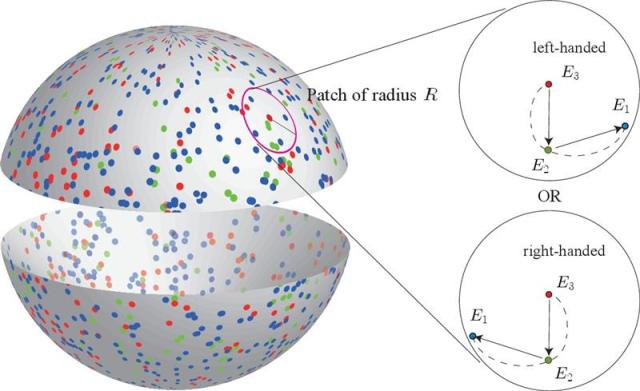May 15 2015
The discovery of a ‘left-handed’ magnetic field that pervades the universe could help explain a long standing mystery – the absence of cosmic antimatter. A group of scientists, led by Prof Tanmay Vachaspati from Arizona State University in the United States, with collaborators at Washington University and Nagoya University, announce their result in Monthly Notices of the Royal Astronomical Society.
 Illustration of the Fermi Gamma ray Space Telescope (FGST) map of the sky with the central band removed to block out gamma rays originating in the Milky Way. Gamma rays of different energies are represented by dots of various colors – red dots represent arrival locations of very energetic gamma rays, green dots represent lower energy, and blue dots represent lowest energy. Credit: Hiroyuki Tashiro
Illustration of the Fermi Gamma ray Space Telescope (FGST) map of the sky with the central band removed to block out gamma rays originating in the Milky Way. Gamma rays of different energies are represented by dots of various colors – red dots represent arrival locations of very energetic gamma rays, green dots represent lower energy, and blue dots represent lowest energy. Credit: Hiroyuki Tashiro
Planets, stars, gas and dust are almost entirely made up of ‘normal’ matter of the kind we are familiar with on Earth. But theory predicts that there should be a similar amount of antimatter, like normal matter, but with the opposite charge. For example, an antielectron or positron has the same mass as its conventional counterpart, but a positive rather than negative charge.
In 2001 Prof Vachaspati published theoretical models to try to solve this puzzle, which predict that the entire universe is filled with helical (screw-like) magnetic fields. He and his team were inspired to search for evidence of these fields in data from the NASA Fermi Gamma ray Space Telescope (FGST).
FGST, launched in 2008, observes gamma rays (electromagnetic radiation with a shorter wavelength than X-rays) from very distant sources, such as the supermassive black holes found in many large galaxies. The gamma rays are sensitive to effect of the magnetic field they travel through on their long journey to the Earth. If the field is helical, it will imprint a spiral pattern on the distribution of gamma rays.
Vachaspati and his team see exactly this effect in the FGST data, allowing them to not only detect the magnetic field but to measure its properties. The data shows not only a helical field, but show that there is an excess of left-handedness - a fundamental discovery that for the first time suggests the precise mechanism that led to the absence of antimatter.
For example, mechanisms that occur nanoseconds after the Big Bang, when the Higgs field gave masses to all known particles, predict left-handed fields, while mechanisms based on interactions that occur even earlier predict right-handed fields.
Prof Vachaspati commented: “Both the planet we live on and the star we orbit are made up of ‘normal’ matter, and though it features in many science fiction stories, antimatter seems to be incredibly rare in nature. With this new result, we have one of the first hints that we might be able to solve this mystery.”
This discovery has wide ramifications, as a cosmological magnetic field could play an important role in the formation of the first stars and could seed the stronger field seen in galaxies and clusters of galaxies in the present day.